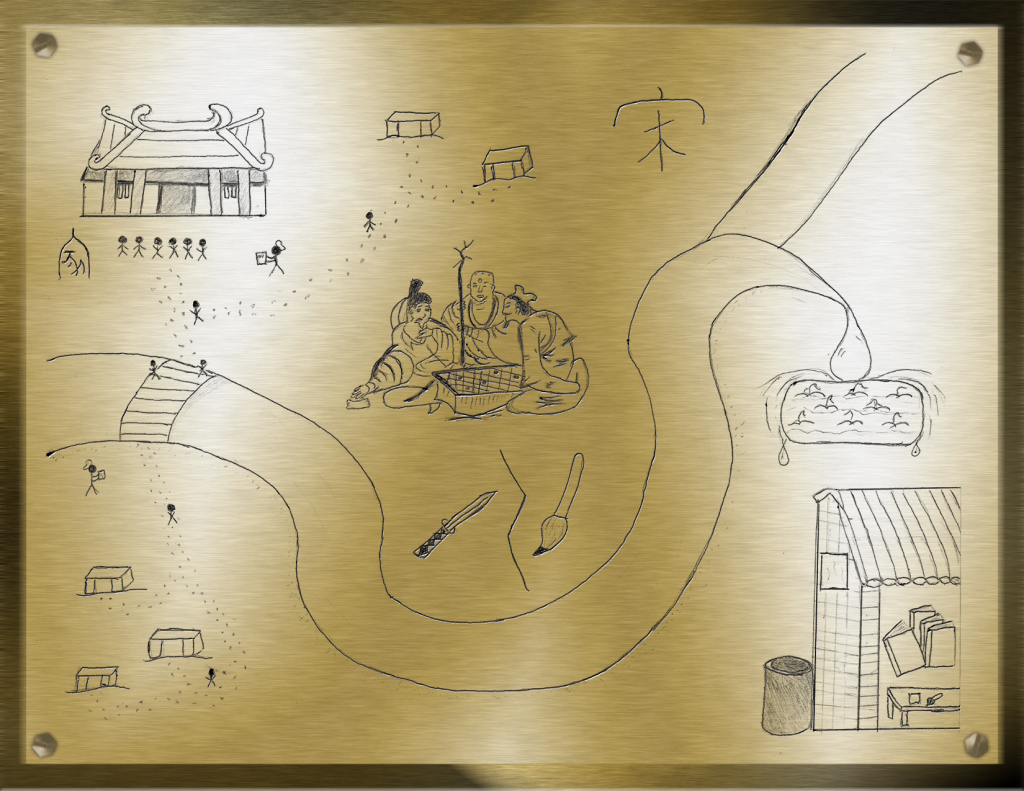
| Time Period | ca. 1195 CE |
| Geographical Region | North area of Southern Song |
| List of Symbols |
|
The symbols on this plaque represent events and significant cultural ideas that a typical Chinese person in the North of Southern Song would have been aware of. The specific time period is set in the late 1190’s, around the turn of the century, an exciting time in China as the Jurchens (The Jin Dynasty) from the North amassed more power. Geographically, the plaque is designed to have originated from just south of the Yellow River, as indicated by the effects of the river on the people’s lives.
In the top right corner of the plaque is the traditional Chinese character for Song, this is to indicate that the plaque is from this time period. In the center of the plaque is a Buddhist, a Confucian, and a Daoist playing chess. The original design came from a pillow found from around this era and it represents the popularity of the Complete Self-Realization School. This school of thought was invented by a man who, after failing the civil service examinations, decided to combine Buddhist, Daoist, and Confucian teachings into this new religion in the year 1160. He selected the texts The Classic of Filial Piety, The Way and Integrity Classic, and The Heart Sutra. The school became popular because it offered a refuge to those displaced by the wars. Specifically, it offered support to women and their children who had lost their husbands to the wars. The school allowed women and men to interact freely and it became popular among women, who would sometimes leave their families after their children had grown to further pursue the religion.
Under the chess players is a sword and a brush divided by a line. This symbolizes the divide between the army generals and literati that plagued the Song Dynasty. This divide is part of what led to the decline of the Song Dynasty and led to the tumultuous experiences of people during this time.
Cutting through the center of the plaque is the Yellow River. At the upper right corner, instead of continuing further up, it veers down and floods a drawing of crops. This depicts the 1194 floods that took place when the Yellow River, instead of flowing north through the Shandong province, flooded south, killing many crops. The flooding continued for thirty years after 1194, which led to financial devastation and created an opening for the Southern Song to mount more failed attempts at attack on the Jin.
Under the flooded crops is a depiction of a civil service examination cell. This is to indicate that the civil service examinations remained a significant focus in Chinese culture during this time period because of the social mobility they provided. Inside the cell are the Four Books: The Analects, The Doctrine of the Mean, Mencius, and Great Learning. Each scholar had to study these books for years before sitting for the several days long exams.
At the top of the plaque and at the bottom right corner, small stone houses are drawn with a beaten down path of footsteps and people walking to the same place on it. During this time period people native to the Song dynasty area, especially those related to the royal family, were amassing many slaves. Along the path are two census takers that represent the 1195 government sponsored census. It was recorded that there were an average of 6.55 people per house, a record high. However, this was not due to growing family size. The inflation was caused by all the slaves coming into the country to serve the affluent families, although the origin of the slaves was not recorded. This is depicted by the house with traditional Song Dynasty architecture in the top left corner. In front of the house stands 6 people with one person heading towards it. These people represent the 6.55 average people in each household, and the building is distinguished as a house by the traditional Chinese character for house next to it.
The turn of the twelfth century was an eventful time in China, characterized by natural disasters, government conflicts, population growth, and religious awakenings. The area around the Yellow River experienced the effects of the time most directly, as it was located in the middle of the fighting and the people were at the mercy of the river’s behavior. The drawing on the plaque symbolize just some of events and ideas that had a significant cultural impact on the everyday people.
KATIE MCKENDRICK is a sophomore at the University of Rochester. She is a double major in Environmental Studies and East Asian Studies. In her free time she likes to run and read.
